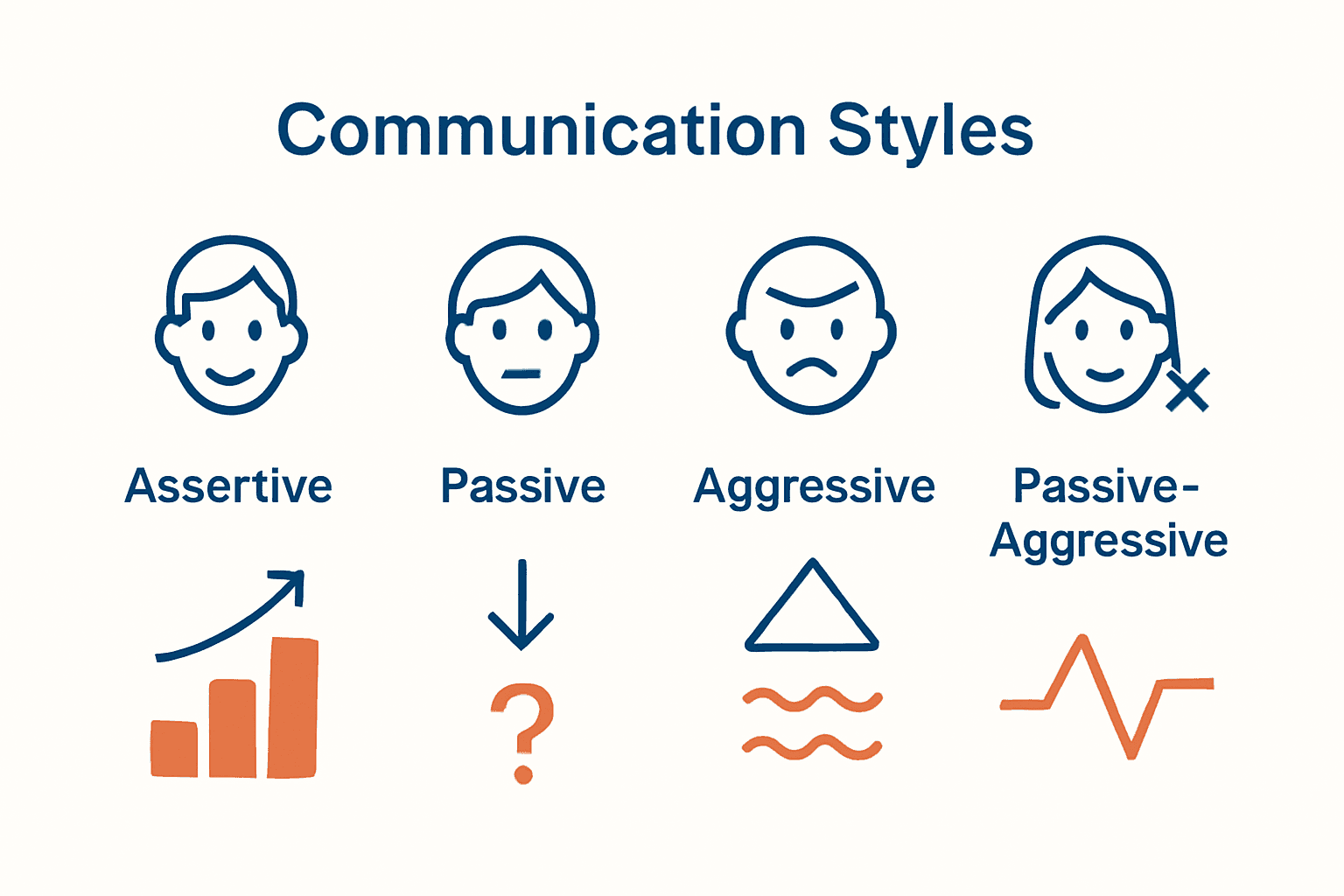Healthy Communication in Relationships Explained

Did you know that nearly 65 percent of couples cite communication issues as the main reason for relationship breakdowns? The way partners talk, listen, and respond shapes trust, intimacy, and lasting happiness. Whether you want deeper connections or need new conflict tools, understanding what healthy communication looks like unlocks real transformation. Discover the core habits, styles, and proven strategies that support honest conversations and lasting emotional bonds.
Table of Contents
- Defining Healthy Communication In Relationships
- Different Communication Styles And Their Impact
- Core Principles Of Effective Dialogue
- Barriers To Healthy Communication Dynamics
- Strategies For Managing Conflict Constructively
- Cultural And Individual Factors Influencing Communication
Key Takeaways
| Point | Details |
|---|---|
| Healthy Communication | Effective communication combines active listening, emotional intelligence, and clarity in expressing needs, fostering meaningful connections. |
| Communication Styles | Recognizing and adapting communication styles (assertive, passive, aggressive, passive-aggressive) is vital for enhancing relationship dynamics. |
| Effective Dialogue | Engaging in empathetic and collaborative dialogue creates a safe space for expression and understanding, essential for conflict resolution. |
| Conflict Management | Viewing conflicts as opportunities for growth rather than threats encourages constructive communication and strengthens relationships. |
Defining Healthy Communication in Relationships
Healthy communication is the foundational skill that transforms relationships from transactional interactions to meaningful connections. At its core, communicative competence involves effectively conveying, interpreting, and responding to messages across different contexts, requiring linguistic, social, and strategic abilities.
According to research from communication experts, healthy communication transcends mere verbal exchange. It encompasses active listening, emotional intelligence, and the capacity to understand nuanced communication styles. Understanding the key differences between healthy and unhealthy anger becomes crucial in developing robust relationship communication skills.
As Deborah Tannen’s groundbreaking work highlights, communication styles can significantly vary between individuals, particularly across gender lines. These differences don’t represent barriers but opportunities for deeper understanding. Effective communication requires:
- Genuine emotional transparency
- Respectful listening without judgment
- Expressing needs clearly and compassionately
- Maintaining empathy during difficult conversations
- Practicing mutual validation
Successful relationships aren’t about eliminating disagreements but navigating them with mutual respect, understanding, and a commitment to collective growth.
Different Communication Styles and Their Impact
Understanding communication styles is crucial for building healthier relationships, as each approach dramatically influences interpersonal dynamics. According to research, individuals typically default to one of four primary communication styles: assertive, passive, aggressive, or passive-aggressive, each with unique characteristics and potential relationship consequences.
Research from scientific studies indicates that variations in communication styles, including verbosity and structural approach, significantly impact interaction effectiveness. 21 Ways to Control Anger in a Relationship can help individuals recognize and modify their communication patterns.
Let’s break down these communication styles:
Here’s a comparison of the four primary communication styles:
| Communication Style | Key Characteristics | Potential Impact on Relationships |
|---|---|---|
| Assertive | Direct Respectful Clear boundaries | Promotes trust Encourages openness |
| Passive | Avoids conflict Suppresses needs Indecisive | Leads to resentment Lack of clarity |
| Aggressive | Domineering Interrupts Disregards others | Causes tension Erodes trust |
| Passive-Aggressive | Indirect Subtle resistance Sarcasm | Fosters confusion Undermines communication |

- Assertive: Direct, respectful, balanced communication where needs are expressed clearly without undermining others
- Passive: Indirect communication, often avoiding conflict by suppressing personal needs
- Aggressive: Dominant communication style prioritizing personal needs while disregarding others’ feelings
- Passive-Aggressive: Indirect expression of negative feelings through subtle, often manipulative behaviors
Successful communicators learn to recognize their default style and adapt flexibly, understanding that effective communication isn’t about winning, but creating mutual understanding and respect.

Core Principles of Effective Dialogue
Effective dialogue is an intricate dance of communication that goes beyond simply exchanging words. It requires intentional strategies that create genuine connection and mutual understanding. Research in communication science reveals that the most powerful conversations are built on a foundation of empathy, active listening, and collaborative engagement.
According to research on motivational interviewing, empathetic communication significantly enhances conversational engagement and interest. This approach prioritizes understanding the other person’s perspective before presenting one’s own viewpoint. How to Deal With Parenting Conflicts illustrates how these principles can transform challenging interactions.
Key principles of effective dialogue include:
- Creating a safe, non-judgmental space for expression
- Practicing active and reflective listening
- Asking open-ended questions that invite deeper exploration
- Validating emotions before addressing content
- Maintaining respectful body language and tone
- Suspending personal assumptions and preconceptions
Research on leadership communication emphasizes that supportive and expressive dialogue styles are associated with more positive outcomes. The goal isn’t to win an argument, but to create a collaborative environment where both parties feel heard, respected, and understood.
Barriers to Healthy Communication Dynamics
Communication barriers can silently erode relationships, creating invisible walls that prevent genuine understanding and connection. These obstacles emerge from various psychological, emotional, and social factors that disrupt effective dialogue and emotional intimacy between partners.
Research reveals that deficiencies in communication skills can profoundly impact mental health, potentially increasing anxiety and depression among individuals. Enhance Your Relationship: Couples Communication Exercises offers practical strategies to overcome these challenges and rebuild communicative pathways.
Key barriers to healthy communication include:
- Emotional defensiveness: Automatically protecting oneself instead of listening
- Unresolved past conflicts: Carrying emotional baggage from previous interactions
- Assumptions and mind-reading: Believing you know what your partner thinks without verification
- Fear of vulnerability: Avoiding genuine emotional exposure
- Ineffective listening: Preparing responses instead of truly hearing
Gender-based communication differences can further complicate interactions, with research suggesting that men and women often have fundamentally different communication approaches. Understanding and acknowledging these differences becomes crucial in breaking down communicative barriers and creating more empathetic, nuanced dialogues that foster mutual understanding and emotional connection.
Strategies for Managing Conflict Constructively
Conflict management is an essential skill that transforms potential relationship-destroying moments into opportunities for deeper understanding and growth. Rather than viewing conflicts as threats, successful partners recognize them as chances to strengthen emotional connections and improve mutual comprehension.
Research on motivational interviewing reveals that empathetic and collaborative communication can effectively navigate challenging interactions. Effective Conflict Resolution Steps for Couples, Families, and Professionals 2025 provides comprehensive insights into transforming conflicts into constructive dialogues.
Key strategies for managing conflict constructively include:
- Active listening: Focusing entirely on understanding your partner’s perspective
- Emotional regulation: Managing personal reactions before responding
- Using “I” statements: Expressing feelings without blaming or attacking
- Seeking understanding: Asking clarifying questions to gain deeper insights
- Practicing empathy: Genuinely attempting to feel and understand your partner’s emotional experience
Leadership communication research emphasizes that adopting supportive and expressive communication styles can create positive environments conducive to resolving conflicts. The ultimate goal isn’t to win an argument, but to collaborate, validate each other’s experiences, and find mutually satisfying resolutions that strengthen the relationship’s foundation.
Cultural and Individual Factors Influencing Communication
Communication dynamics are deeply rooted in complex cultural and individual landscapes, creating intricate patterns of interaction that extend far beyond simple verbal exchange. Each person brings a unique combination of personal history, social background, and linguistic competencies that shape their communicative approach.
According to research on linguistic and social competencies, individual factors play a significant role in communication effectiveness across different contexts. 8 Good Reasons Couples Should Embrace Conflict highlights how understanding these individual differences can transform relationship interactions.
Key cultural and individual communication factors include:
- Language background: Variations in linguistic styles and vocabulary
- Family communication patterns: Learned behaviors from childhood
- Emotional intelligence: Ability to recognize and manage emotional nuances
- Cultural norms: Societal expectations and communication rules
- Personal trauma history: Past experiences influencing communication strategies
Research on gender communication differences reveals that distinct communication styles can lead to profound misunderstandings. These variations aren’t barriers but opportunities for deeper understanding, requiring empathy, patience, and a genuine commitment to bridging communicative gaps between individuals with diverse backgrounds and experiences.
Strengthen Your Relationship Through Healthy Communication
Struggling to break down barriers like emotional defensiveness or unclear needs in your relationship? If you want to move beyond the common pitfalls of passive or aggressive communication and build a foundation based on empathy, active listening, and mutual respect, you are not alone. Our professionals at Mastering Conflict understand how complex communication styles affect your connection and can guide you toward healthier dialogue.

Take the first step now by exploring personalized anger management classes and couples therapy designed to equip you with practical tools for managing conflict and expressing your needs clearly. Visit Mastering Conflict to learn how clinical interventions and coaching programs can help you transform difficult conversations into opportunities for growth and lasting understanding. Don’t wait to create the healthy, open communication your relationship deserves.
Frequently Asked Questions
What is healthy communication in relationships?
Healthy communication in relationships is the ability to convey, interpret, and respond to messages effectively. It includes active listening, emotional intelligence, and respectful dialogue, fostering deeper connections and mutual understanding.
What are the different communication styles in relationships?
The four primary communication styles are assertive, passive, aggressive, and passive-aggressive. Each style has its unique characteristics and impacts relationships differently, with assertive communication being the most beneficial for fostering trust and understanding.
How can I improve my communication skills in a relationship?
To improve your communication skills, practice active listening, express your needs clearly, maintain empathy, and validate your partner’s feelings. Creating a safe space for open dialogue also enhances communication.
What are common barriers to healthy communication?
Common barriers include emotional defensiveness, unresolved past conflicts, assumptions about your partner’s thoughts, fear of vulnerability, and ineffective listening. Awareness of these barriers can help partners address and overcome them effectively.

It’s arduous to search out knowledgeable folks on this matter, however you sound like you realize what you’re speaking about! Thanks